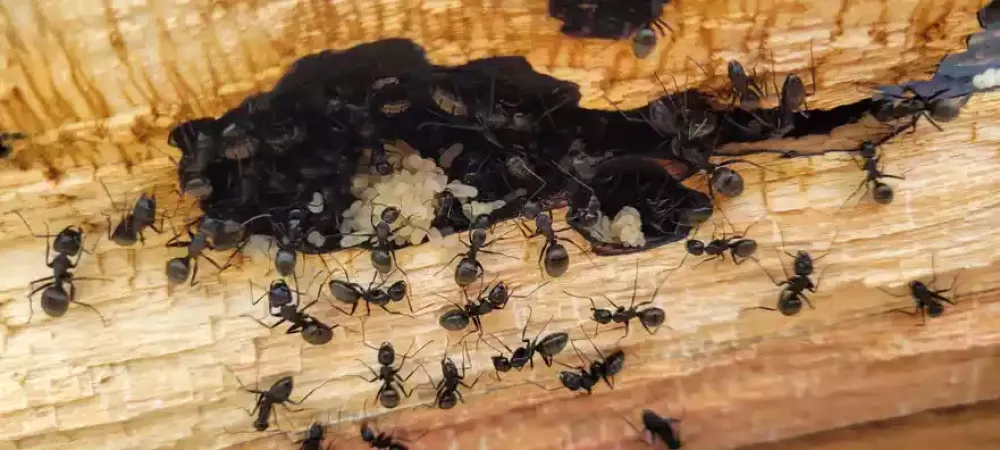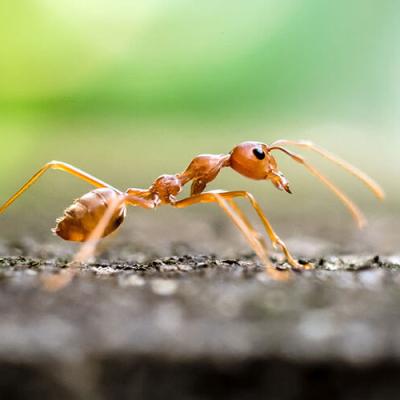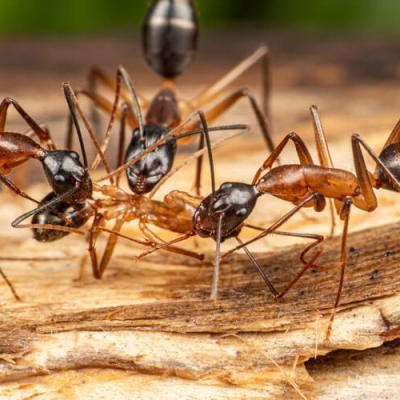
Double Trouble — Managing Fire Ants and Carpenter Ants in Mississippi Gulf Coast Homes
Fire ants and carpenter ants pose significant threats to Mississippi Gulf Coast homes, with fire ants creating painful outdoor hazards and carpenter ants causing structural damage indoors. The region's warm, humid climate provides ideal conditions for both species to thrive year-round. Effective management requires species-specific identification and treatment approaches, as fire ants need aggressive outdoor colony elimination while carpenter ants require moisture control and structural repairs to prevent wood damage.
What Are Fire Ants and Carpenter Ants?

Fire ants and carpenter ants represent two distinct ant species that commonly infest Mississippi Gulf Coast properties, each presenting unique challenges for homeowners. Fire ants, primarily red imported fire ants (Solenopsis invicta), are aggressive outdoor ants that build large mound colonies and deliver painful, venomous stings. These invasive pests arrived in the Gulf Coast region in the 1940s and have since become one of the most serious pest problems in the area, with colonies containing up to 500,000 workers.
Carpenter ants are large, black ants that excavate wood to create nesting galleries, potentially causing significant structural damage over time. Unlike termites, carpenter ants don't eat wood but remove it to create smooth tunnels for their colonies. The Mississippi Gulf Coast's high humidity and frequent moisture issues create ideal conditions for carpenter ant infestations, as they prefer damp, softened wood for nest construction.

Both species thrive in the Gulf Coast's subtropical climate, with fire ants remaining active year-round and carpenter ants showing increased activity during warm, humid months. Understanding these pests' biology and behavior is crucial for effective management, as treatment strategies differ significantly between outdoor fire ant colonies and indoor carpenter ant structural infestations.
Key Benefits of Professional Ant Management
Accurate Species Identification and Targeted Treatment
Professional pest control ensures the correct identification of fire ant and carpenter ant species, preventing ineffective treatment attempts. Fire ants require colony-killing baits and mound treatments, while carpenter ants need moisture source elimination and structural void treatments. Misidentification often leads to wasted time and continued infestations.
Structural Damage Prevention and Assessment
Expert carpenter ant management includes identifying and addressing moisture problems that attract these pests to wooden structures. Professionals can assess existing damage, recommend repairs, and implement prevention strategies that protect your home's structural integrity long-term.
Safe and Effective Treatment Application
Fire ant management requires specialized knowledge of bait placement and timing to achieve colony elimination without endangering children, pets, or beneficial insects. Professional application ensures treatments reach target pests while minimizing environmental impact and health risks.
Long-term Population Control and Monitoring
Effective ant management extends beyond initial treatment to include ongoing monitoring and maintenance programs. Professionals understand seasonal activity patterns and can adjust treatment strategies based on weather conditions and colony development cycles specific to the Mississippi Gulf Coast.
Types of Ant Problems in Gulf Coast Homes
Fire Ant Infestations
What They Are: Fire ants are aggressive, reddish-brown ants that build large dirt mounds in yards, gardens, and outdoor recreational areas. These invasive pests create extensive underground tunnel networks that can spread across your entire property.
Where You'll Find Them: Open lawn areas, around trees and shrubs, near sidewalks and driveways, and in sunny locations throughout your yard. Fire ants prefer disturbed soil and avoid heavily shaded areas.
Warning Signs:
- Dome-shaped dirt mounds with no visible entrance holes
- Aggressive ants that swarm and attack when mounds are disturbed
- Painful, burning stings that develop into white pustules
- Multiple mounds appear across your property over time
Why They're Dangerous: Fire ant stings pose serious health risks, especially for children, elderly individuals, and anyone with allergies. Their aggressive nature makes outdoor activities hazardous and can significantly impact property enjoyment.
Carpenter Ant Infestations
What They Are: Large, black ants that excavate smooth tunnels and galleries inside wooden structures to create their nests. Unlike termites, they don't eat wood but remove it to build their colonies.
Where You'll Find Them: Inside moisture-damaged wood around windows, doors, roof lines, and crawl spaces. They particularly target areas with leaks, poor ventilation, or wood-to-ground contact.
Warning Signs:
- Small piles of sawdust-like material (frass) near wooden structures
- Hollow-sounding wood when tapped
- Rustling or scratching sounds inside the walls at night
- Large black ants trailing between indoor and outdoor areas
Why They're Problematic: Carpenter ants can cause significant structural damage over time, weakening support beams, floor joists, and other critical wooden components. Damage often goes unnoticed until it becomes extensive and expensive to repair.
Combined Infestations
The Double Threat: Many Mississippi Gulf Coast properties face both fire ant outdoor problems and carpenter ant structural issues simultaneously. This creates a complex situation requiring different treatment approaches for each species.
Why This Happens: The region's warm, humid climate provides ideal conditions for both species throughout the year. Properties with landscaping, moisture issues, and wood construction are particularly susceptible to dual infestations.
Management Challenges: Successfully addressing both problems requires coordinated strategies, as treatments effective for one species may not work for the other. Professional assessment helps determine the most efficient approach for comprehensive control.
How to Manage Fire Ants and Carpenter Ants
Step 1: Accurate Identification and Assessment
Distinguish between fire ant mounds and carpenter ant sawdust piles (frass). Fire ant mounds appear as loose dirt piles without visible entry holes, while carpenter ant activity shows as small piles of wood shavings near wooden structures. Document locations, activity levels, and any structural damage before beginning treatment.
Step 2: Targeted Treatment Application
For fire ants, apply slow-acting baits when ants are actively foraging (typically morning or evening hours). For carpenter ants, locate and treat the nesting areas directly, while also addressing moisture sources that attract them to wooden structures. Never use the same treatment methods for both species, as their biology requires different approaches.
Step 3: Monitor and Maintain Results
Check fire ant bait stations weekly and replace them as needed until the colony is eliminated (typically 6-8 weeks). Monitor carpenter ant activity areas monthly and maintain moisture control measures throughout the year. Document treatment effectiveness and adjust strategies based on seasonal activity patterns.
Gulf Coast-Specific Considerations
High Humidity and Moisture Challenges
The region's average humidity of 70-80% creates constant moisture problems that attract carpenter ants to wooden structures. Homes require enhanced ventilation, dehumidification, and regular moisture monitoring to prevent infestations.
Hurricane Season Structural Damage
Storm damage creates new entry points and moisture issues that both fire ants and carpenter ants take advantage of. Post-storm inspections should include monitoring for ant activity and immediate repairs to prevent establishment.
Year-Round Fire Ant Activity
Unlike northern climates, Mississippi Gulf Coast fire ants remain active throughout the winter months, requiring continuous monitoring and treatment rather than seasonal approaches.
Common Mistakes to Avoid
Using Generic Ant Sprays for Species-Specific Problems
Contact sprays may kill visible ants, but don't eliminate colonies and can actually make fire ant problems worse by causing colony splitting. Fire ants require baits that workers carry back to kill queens, while carpenter ants need direct nest treatment and moisture elimination.
Ignoring Moisture Sources in Carpenter Ant Management
Treating carpenter ant workers without addressing leaks, poor ventilation, or wood-to-soil contact allows new colonies to establish quickly. Structural moisture control is essential for long-term carpenter ant prevention.
Attempting Fire Ant Mound Treatments During Peak Activity
Disturbing fire ant mounds during midday heat or immediate post-rain periods, when ants are most aggressive, increases sting risk and treatment failure. Optimal treatment timing is crucial for both safety and effectiveness.
Frequently Asked Questions
Are fire ant stings dangerous for my family? Fire ant stings cause immediate burning pain followed by pustule formation within 24 hours. While most people experience localized reactions, some individuals may develop severe allergic responses requiring immediate medical attention. Children and pets are particularly vulnerable due to their size and curiosity.
How can I tell if carpenter ants are damaging my home's structure? Look for small piles of sawdust-like material (frass) near wooden structures, hollow-sounding wood when tapped, and rustling sounds within walls during quiet evening hours. Carpenter ant damage develops slowly but can become extensive in moisture-prone areas like bathrooms, kitchens, and crawl spaces.
Why do I keep getting ant problems after treatment? Incomplete colony elimination allows populations to recover quickly, particularly with fire ants that can split colonies when disturbed improperly. Carpenter ant problems often return when moisture sources aren't addressed, creating conditions that continue attracting new colonies to the same areas.
When should I call professionals instead of trying DIY methods? Contact professionals when dealing with multiple fire ant mounds, suspected carpenter ant structural damage, or recurring problems despite DIY attempts. Fire ant allergies, extensive property infestations, and structural damage assessment require expert knowledge and specialized equipment.
Professional Ant Control for the Mississippi Gulf Coast
Managing both fire ants and carpenter ants requires species-specific expertise and treatment approaches that most homeowners cannot safely or effectively implement alone. The experts at Mayley's Pest Control understand the unique challenges of Gulf Coast ant problems and have the knowledge and specialized equipment to eliminate colonies while protecting your family and property from future infestations.
